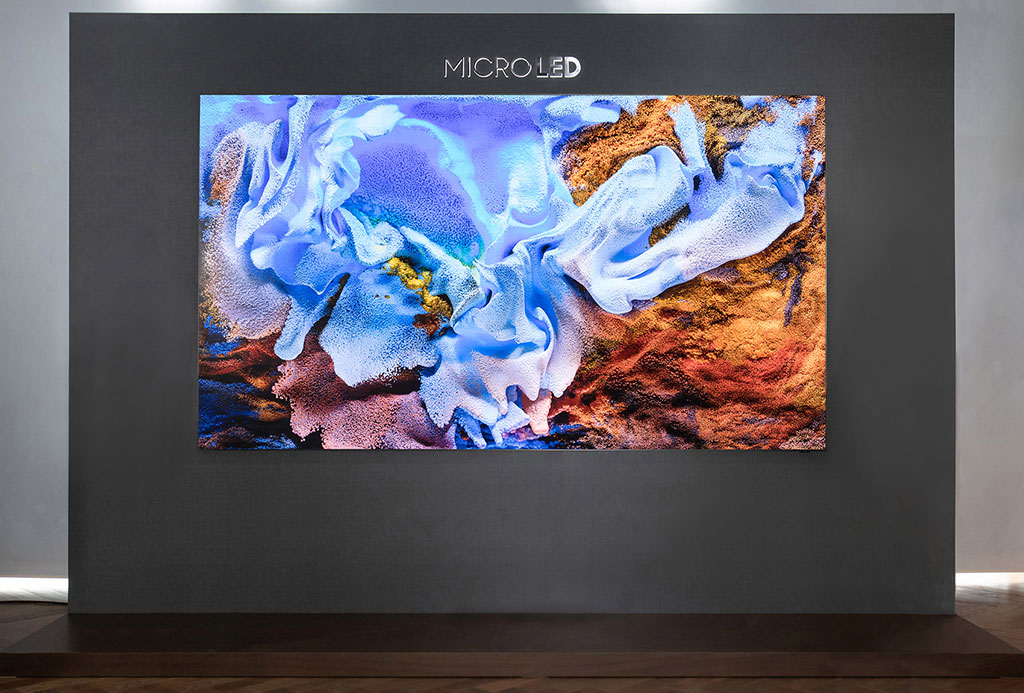The first Micro LED TV has arrived but it's 110 inches and undoubtedly stupid expensive
Samsung's new 110-inch TV uses game changing micro LED technology.

It took a minute (years, actually), but Samsung has finally unveiled a micro LED display for consumers. Check that, it's for wealthy consumers, I presume. There is no mention of a price, but this is a giant 110-inch TV using cutting edge display technology, so don't expect it to be remotely cheap. That's okay, because this is the first step in an exciting transition.
Well, potentially, anyway. To understand what's so exciting about micro LED technology, we need to compare the two dominant standards today, those being LED and OLED.
Each have their strengths and weaknesses. Without taking a deep dive into each one, the primary difference is the presence or lack of a backlit. LED displays use backlighting to illuminate the pixels. This allows them to get super bright in some instances, and they are cheaper than OLED, but can suffer from things like backlight bleed and, in the case of full-array local dimming (FALD), blooming. Otherwise known as the halo effect, this is when lighting in a particular zone spills out into neighboring zones. This is most pronounced with white objects on a black background.
OLED, on the other hand, is an emissive technology. That means each pixel lights up individually (there is no traditional backlight). This allows for deeper and true black levels, and generally produces a better picture. However, OLED displays are prone to burn-in, and are more expensive than regular LED (though costs are coming down).
Enter micro LED. Not to be confused with mini LED technology, micro LED is an emissive technology like OLED, but without the threat of burn-in. It is basically the best of both worlds.
Two years ago, Samsung trotted out a ginormous micro LED display at CES called The Wall, which is intended for business and enterprise clients. Its 110-inch TV is its first consumer micro LED product, and it's here (well, it's in Korea).
"As consumers rely on their televisions for more functions than ever, we are incredibly excited to bring the 110-inch micro LED to the commercial market," said Jonghee Han, president of visual display business at Samsung Electronics. "Samsung micro LED is going to redefine what premium at-home experiences mean for consumers around the world."
Keep up to date with the most important stories and the best deals, as picked by the PC Gamer team.

Best gaming monitor: pixel-perfect panels for your PC
Best 4K monitor for gaming: when only high-res will do
Best 4K TV for gaming: big-screen 4K PC gaming
According to Samsung, mass producing a micro LED TV "as small as 110 inches for simple home installation" just was not possible. But it has now done it, using some kind of cutting-edge surface mount technology, and a new production process (Samsung has gone into details on these aspects of production).
Samsung may consider that small, though to the rest of us, that is truly big. It also offers accurate color reproduction, boasting 100 percent coverage of DCI and Adobe RGB color gamuts.
This is a 4K set, as it seems micro LED is not yet at the point where it can go higher, whereas other display technologies have already hit 8K. The content is not really there anyway, though perhaps it will be during this TV's lifespan—it is rated for 100,000 hours, which equates to more than 11 years of non-stop usage. Users can also split the screen into four 55-inch views, fed by separate sources.
Following today's unveiling in Korea, Samsung says its 110-inch micro LED TV will be available globally in the first quarter of next year. As for pricing, Samsung's 98-inch Q900 QLED (8K) TV currently lists for $100,000 (but it's on sale for $60,000).
Paul has been playing PC games and raking his knuckles on computer hardware since the Commodore 64. He does not have any tattoos, but thinks it would be cool to get one that reads LOAD"*",8,1. In his off time, he rides motorcycles and wrestles alligators (only one of those is true).


